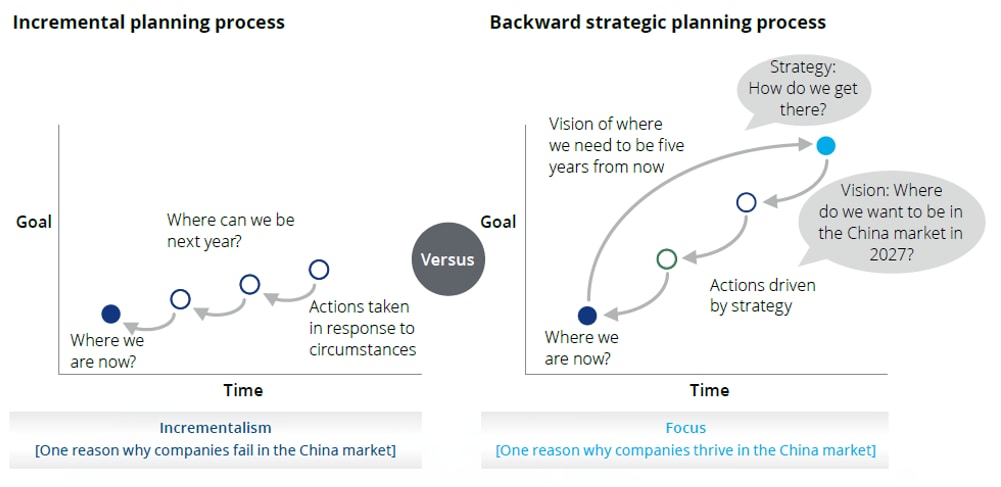Article

MNC Localization 2.0
Published: 16 December 2022
MNCs’ journey in China

- 0. Sell to China: China’s population size made it an attractive market for MNCs and their production stayed out of China.
- 1. Make in China: MNCs started to produce in China as China’s labor force expanded in size and improved in quality, China
aggressively built up its infrastructure, and import tariffs were high.
- 2. Supply from China: MNCs began exporting their products from China to other markets because of the production cost efficiency in China and low import and export tariffs.
- 3. In China, for China and the World : The China market itself became so large and so competitive that MNCs started to tailor some of their products for the China market. At the same time, China remained a production hub for MNCs’ supply to other markets.
- 4. China +1 or 2: Increasing export costs to the US combined with China’s plan of expanding its domestic market accelerated some MNCs’ progress of moving part of the production out of China.
- 5. What’s next? Increasing uncertainty in the China market in a more fragmented world imposes increasing operation risk for MNCs in China. How should MNCs reshape their China strategy?
Existing and New Challenges for MNCs determined to win the China market

Localization 2.0: MNCs’ strategy to resolve the above three new challenges


MNCs’ desired position in the China market should be based on their global strategy, and some MNCs may choose to win the China market in the next five years while some others may not. The Chinese economy is evolving, which means that new challenges will always emerge from time to time. For those that have decided to win the China market, they need to have a vision into the next five years and develop their strategies accordingly and to strategically respond to the changing circumstances. From the experiences of successful and unsuccessful MNCs in China, this sort of “focused” approach works far better than an “incremental” approach where MNCs only take short-term actions.
1. Supply chain localization
- MNCs operating in China need to increase localization of their supply chain. Over the next five years, there are two important trends that will shift the balance towards sourcing locally. The first trend is rising global shipping costs. Because of rising fuel prices, geopolitical tensions, as well as the increasing awareness of ESG, shipping costs are likely to be higher and higher. The second trend is China’s self-sufficiency initiative that will significantly extend the options for local procurement. Take chips for example, China’s largest domestic chip manufacturer SMIC produced 1,840,189 units of 8nm chips in 2021 Q4, up from 1,315,443 units in 2019 Q3 when the US banned selling chips to Huawei.
2. R&D localization
- F or a long time, technical advantages have been the primary edge of MNCs over their local competitors in China. And in the foreseeable future, MNCs will still have to rely on advanced technology to secure their market share in China. However, this will be increasingly difficult as local Chinese companies have been spending relentlessly on R&D and are rising quickly in the technology front.
- Due to increasing competition in the China market, many MNCs have been expanding their Chinese-based R&D. But most are still hesitant when it comes to putting core R&D in China for various reasons, such as IP protection. Over the next five years, increasing emphasis on technology and data sovereignty will make it a must for MNCs to develop core technologies in China, not just for winning in the local market but also for risk control.
3. Finance localization
- A financial decoupling between the US and China, although not an eminent threat, is a real risk. More and more Chinese companies are being delisted – some passively and some others actively – from the US stock market. There is also increasing pressure in the US on restricting investment in China. MNCs headquartered in the US need to be prepared for the risk of financial decoupling.
- Another force that calls for the MNCs to localize their finance in China is the need to support growth locally in China. Traditionally MNCs’ operation in China has relied on investments from HQ as well as retained profit, which has its limitations in both investment size and investment speed. Especially in the fast-growing industries such as healthcare technology and EVs, local companies are actively investing in their own R&D as well as investing in (or fully acquiring) innovative enterprises, while MNCs remain relatively slow. To capture the growth momentum in those sectors, MNCs need to turn to local financial markets to finance their operation in China.
Conclusion
Localization has been a continuous theme for MNCs operating in the evolving China market. We are now at a point where MNCs need to localize not just to compete in the China market but also to control the increasing risks surrounding supply chain disruption, technology and data sovereignty, and US-China financial decoupling. MNCs that seek to win in the China market in the next five years need to deepen their localization strategies along these three directions.
Author
Dr. Zhang, Guoxiong
Managing Director
Economic Advisory
Email: guoxizhang@deloitte.com.cn
Contact us
Chu, Penny Xiaopei
Partner
Financial Advisory MNC Service Group Leader
Email: pechu@deloitte.com.cn
Lah, Stanley
Partner
Deloitte Asia-Pacific and China End-to-End M&A Leader
Email: slah@deloitte.com.cn
Yu, Michael Zheng
Partner
Financial Advisory National M&A Leader
Email: micyu@deloitte.com.cn
Wang, Constance Huan
Director
Financial Advisory End-to-End M&A Director
Email: conswang@deloitte.com.cn
Waddelove, Nicholas James
Director
Financial Advisory End-to-End M&A Director
Email: nwaddelove@deloitte.com.cn
Recommendations
2021 Q1 China CFO Survey Report
Adapting to a new normal: CFOs perspectives and priorities for 2021

